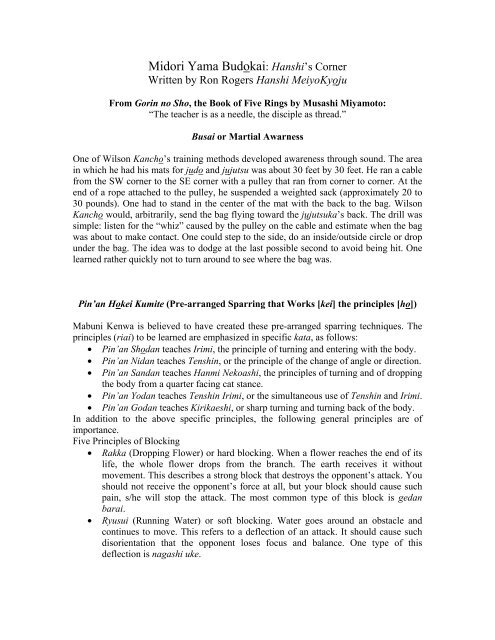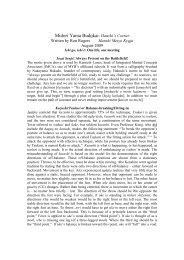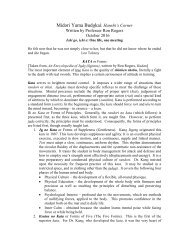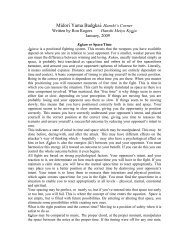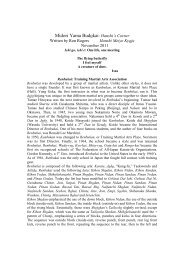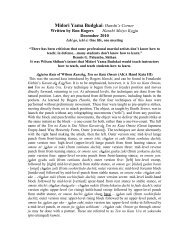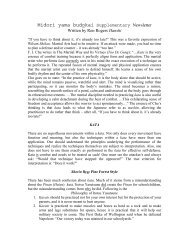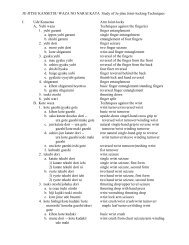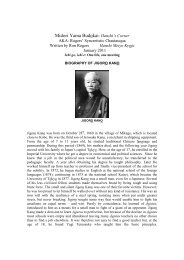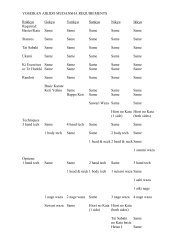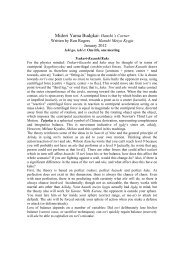Learning Principles from the Pinan Katas and a Short History of ...
Learning Principles from the Pinan Katas and a Short History of ...
Learning Principles from the Pinan Katas and a Short History of ...
Create successful ePaper yourself
Turn your PDF publications into a flip-book with our unique Google optimized e-Paper software.
Midori Yama Budokai: Hanshi’s Corner<br />
Written by Ron Rogers Hanshi MeiyoKyoju<br />
From Gorin no Sho, <strong>the</strong> Book <strong>of</strong> Five Rings by Musashi Miyamoto:<br />
“The teacher is as a needle, <strong>the</strong> disciple as thread.”<br />
Busai or Martial Awarness<br />
One <strong>of</strong> Wilson Kancho’s training methods developed awareness through sound. The area<br />
in which he had his mats for judo <strong>and</strong> jujutsu was about 30 feet by 30 feet. He ran a cable<br />
<strong>from</strong> <strong>the</strong> SW corner to <strong>the</strong> SE corner with a pulley that ran <strong>from</strong> corner to corner. At <strong>the</strong><br />
end <strong>of</strong> a rope attached to <strong>the</strong> pulley, he suspended a weighted sack (approximately 20 to<br />
30 pounds). One had to st<strong>and</strong> in <strong>the</strong> center <strong>of</strong> <strong>the</strong> mat with <strong>the</strong> back to <strong>the</strong> bag. Wilson<br />
Kancho would, arbitrarily, send <strong>the</strong> bag flying toward <strong>the</strong> jujutsuka’s back. The drill was<br />
simple: listen for <strong>the</strong> “whiz” caused by <strong>the</strong> pulley on <strong>the</strong> cable <strong>and</strong> estimate when <strong>the</strong> bag<br />
was about to make contact. One could step to <strong>the</strong> side, do an inside/outside circle or drop<br />
under <strong>the</strong> bag. The idea was to dodge at <strong>the</strong> last possible second to avoid being hit. One<br />
learned ra<strong>the</strong>r quickly not to turn around to see where <strong>the</strong> bag was.<br />
Pin’an Hokei Kumite (Pre-arranged Sparring that Works [kei] <strong>the</strong> principles [ho])<br />
Mabuni Kenwa is believed to have created <strong>the</strong>se pre-arranged sparring techniques. The<br />
principles (riai) to be learned are emphasized in specific kata, as follows:<br />
• Pin’an Shodan teaches Irimi, <strong>the</strong> principle <strong>of</strong> turning <strong>and</strong> entering with <strong>the</strong> body.<br />
• Pin’an Nidan teaches Tenshin, or <strong>the</strong> principle <strong>of</strong> <strong>the</strong> change <strong>of</strong> angle or direction.<br />
• Pin’an S<strong>and</strong>an teaches Hanmi Nekoashi, <strong>the</strong> principles <strong>of</strong> turning <strong>and</strong> <strong>of</strong> dropping<br />
<strong>the</strong> body <strong>from</strong> a quarter facing cat stance.<br />
• Pin’an Yodan teaches Tenshin Irimi, or <strong>the</strong> simultaneous use <strong>of</strong> Tenshin <strong>and</strong> Irimi.<br />
• Pin’an Godan teaches Kirikaeshi, or sharp turning <strong>and</strong> turning back <strong>of</strong> <strong>the</strong> body.<br />
In addition to <strong>the</strong> above specific principles, <strong>the</strong> following general principles are <strong>of</strong><br />
importance.<br />
Five <strong>Principles</strong> <strong>of</strong> Blocking<br />
• Rakka (Dropping Flower) or hard blocking. When a flower reaches <strong>the</strong> end <strong>of</strong> its<br />
life, <strong>the</strong> whole flower drops <strong>from</strong> <strong>the</strong> branch. The earth receives it without<br />
movement. This describes a strong block that destroys <strong>the</strong> opponent’s attack. You<br />
should not receive <strong>the</strong> opponent’s force at all, but your block should cause such<br />
pain, s/he will stop <strong>the</strong> attack. The most common type <strong>of</strong> this block is gedan<br />
barai.<br />
• Ryusui (Running Water) or s<strong>of</strong>t blocking. Water goes around an obstacle <strong>and</strong><br />
continues to move. This refers to a deflection <strong>of</strong> an attack. It should cause such<br />
disorientation that <strong>the</strong> opponent loses focus <strong>and</strong> balance. One type <strong>of</strong> this<br />
deflection is nagashi uke.
• Kusshin (Down <strong>and</strong> up) or up <strong>and</strong> down movements <strong>of</strong> <strong>the</strong> body (“bobbing”).<br />
Kutsu (Kus) means bend <strong>and</strong> shin means stretch. This usually refers to changes <strong>of</strong><br />
stance. An example would be moving <strong>from</strong> shizentai to nekoashi dachi, as <strong>the</strong><br />
latter is lower than <strong>the</strong> former. The reverse (<strong>from</strong> down to up) would be in Heian<br />
Shodan, moving <strong>from</strong> zenkutsu dachi to renoji dachi.<br />
• Ten’i (Change Position) or changes <strong>of</strong> positions <strong>and</strong> angles <strong>of</strong> <strong>the</strong> body. One<br />
should be able to move without losing correct posture, stance or balance. This is<br />
similar to tenshin, but is more general. Tenshin is more specifically used for<br />
“changes in direction.” Examples would be yori ashi (slide in), ayumi ashi (step<br />
in), oi ashi (step back) <strong>and</strong> fumikae (or changing feet [in place]). O<strong>the</strong>rs would be<br />
tsugi ashi (follow step) <strong>and</strong> kosa ashi (cross step). These may be combined with<br />
shomen (front facing, or square on), hanmi (half-front facing) <strong>and</strong> ma-hanmi (side<br />
facing) for greater versatility<br />
• Hangeki (Gyakugeki) or countering. One may punch while avoiding <strong>the</strong><br />
opponent’s attack (kara uke) or use <strong>the</strong> counter to deflect <strong>the</strong> opponent’s attack<br />
(tsuki uke).<br />
Three Ways <strong>of</strong> Producing Shock<br />
• Dropping <strong>of</strong> <strong>the</strong> Body.<br />
• Expansion <strong>and</strong> Contraction <strong>of</strong> <strong>the</strong> Body. Expansion (hari) is also known as<br />
“opening”; contraction (shime) is known as “closing.”<br />
• Fixation <strong>of</strong> all <strong>the</strong> Muscles <strong>of</strong> <strong>the</strong> Body.<br />
Internal Changing <strong>of</strong> <strong>the</strong> Weight. This refers to lowering <strong>the</strong> body weight into <strong>the</strong> t<strong>and</strong>en.<br />
This requires proper abdominal breathing, ei<strong>the</strong>r natural abdominal breathing (kokyu) or<br />
reverse abdominal breathing (kokyu chosei).<br />
A <strong>Short</strong> <strong>History</strong> <strong>of</strong> Shotokan<br />
Funakoshi Gichin did not use <strong>the</strong> term Shotokan Karate-do. Master Funakoshi referred to<br />
what he taught as simply, “karate,” <strong>the</strong> name by which it is known in Japan. Shotokan<br />
was <strong>the</strong> name given to Funakoshi’s karate by his students, <strong>and</strong> actually referred to <strong>the</strong><br />
dojo in which it was originally taught. Shotokan comes <strong>from</strong> three words: “Sho to,” or<br />
“Pine Waves,” <strong>the</strong> nom de plume <strong>of</strong> Funakoshi, <strong>and</strong> “kan,” which means “hall.”<br />
Shotokan, <strong>the</strong>refore, means “<strong>the</strong> [training] Hall <strong>of</strong> Shoto. Funakoshi’s first book was<br />
entitled Ryukyu Kempo Karate, which meant Okinawan Fist Method Chinese H<strong>and</strong>.<br />
When <strong>the</strong> dojo at Keio was opened, Funakoshi suggested <strong>the</strong> name Dai Nippon Kempo<br />
Karate-do (Great Japan Fist Method Empty-h<strong>and</strong> Way). Written with two different<br />
characters, “kara,” may mean ei<strong>the</strong>r “China/Chinese” or “Empty.”<br />
Two innovations <strong>of</strong> Funakoshi were <strong>the</strong> karate-gi, or do-gi, based on <strong>the</strong> judo-gi, <strong>and</strong> <strong>the</strong><br />
custom <strong>of</strong> colored belts, also influenced by Kano’s judo. In addition to <strong>the</strong> fifteen karate<br />
kata brought to Japan by Funakoshi, he also taught Tenryu no Kon, or <strong>the</strong> Staff <strong>of</strong> <strong>the</strong><br />
Heavenly Dragon (bo), <strong>and</strong> <strong>the</strong> use <strong>of</strong> <strong>the</strong> sai; some sources include <strong>the</strong> nunchaku. The<br />
Shotokai still trains with <strong>the</strong> bo.<br />
The long stances <strong>of</strong> Shotokan were actually implemented by Funakoshi’s son, Funakoshi<br />
Yoshitaka (aka Funakoshi Gigo). According to Egami Shigeru, <strong>the</strong> son (known as Waka<br />
Sensei, or Young Teacher) was <strong>the</strong> actual creator <strong>of</strong> <strong>the</strong> Taikyoku Kata (Shodan, Nidan<br />
<strong>and</strong> S<strong>and</strong>an) <strong>and</strong> <strong>of</strong> <strong>the</strong> Ten no Kata (Omote <strong>and</strong> Ura). Funakoshi Yoshitaka also
introduced long range, deep thrusting techniques <strong>and</strong> high kicks. In addition, <strong>the</strong> son<br />
excluded almost all grappling during sparring. The Shotokan taught today is <strong>of</strong> Funakoshi<br />
Yoshitaka, ra<strong>the</strong>r than Funakoshi Gichin. The son died in 1945 <strong>of</strong> complications <strong>of</strong><br />
tuberculosis, which had been diagnosed in 1913. Both fa<strong>the</strong>r <strong>and</strong> son credited karate for<br />
Funakoshi Yoshitaka having lived <strong>the</strong> thirty-two years following what was considered a<br />
death sentence in that era. In a darker vein, Henri Plee, a karate pioneer in France, states<br />
that Yoshitaka was implicated (as well as o<strong>the</strong>rs) in testing <strong>the</strong> efficacy <strong>of</strong> techniques on<br />
prisoners <strong>of</strong> war during <strong>the</strong> years 1942 to 1944.<br />
In 1957, <strong>the</strong> year <strong>of</strong> Funakoshi’s passing, he had named no successor. Consequently, <strong>the</strong><br />
organization split (as do most with <strong>the</strong> passing <strong>of</strong> <strong>the</strong> founder!) into two major factions:<br />
JKA <strong>and</strong> Shotokai. Egami Shigeru, Funakoshi’s leading student, led Shotokai. The<br />
Shotokai did not agree with <strong>the</strong> commercial aspects Shotokan had adopted, or <strong>of</strong> its<br />
competitive aspects. Nakayama Masatoshi led <strong>the</strong> JKA (Japanese Karate Association).<br />
The JKA’s <strong>of</strong>ficial name in Japan is Nihon Karate Kyokai. The JKA promoted<br />
competition <strong>and</strong> held <strong>the</strong> first Japanese Karate Championship in 1957.<br />
Obata Isao, with o<strong>the</strong>rs had withdrawn prior to this major split. Ano<strong>the</strong>r group is Oshima<br />
Tsutomu Shihan’s Shotokan Karate <strong>of</strong> America, founded in 1956. A unique aspect <strong>of</strong> this<br />
organization is its rank structure. Oshima Shihan only awards up to Godan, this being <strong>the</strong><br />
highest rank <strong>of</strong> his organization. This is based on <strong>the</strong> fact that Funakoshi was awarded<br />
only up to Godan rank. Oshima Shihan feels that no one should be promoted above <strong>the</strong><br />
founder; consequently, Godan is <strong>the</strong> SKA’s equivalent to Judan. If someone <strong>from</strong><br />
ano<strong>the</strong>r organization joins Oshima Shihan’s group <strong>the</strong> rank is halved (a JKA (for<br />
example) Yodan would be an SKA Nidan, etc. One <strong>of</strong> Baker Hanshi’s former students,<br />
Bill Riendl attended an SKA training camp. Mr. Riendl has also worked with Oyata<br />
Seiyu, who has a Kenpo school in Merriam, KS. One <strong>of</strong> Oshima’s students, Jordan Roth,<br />
wrote an excellent book on SKA techniques, Black Belt Karate. One <strong>of</strong> this book’s<br />
unique features is depiction <strong>of</strong> techniques Kano Jigoro Shihan incorporated into his judo<br />
in <strong>the</strong> Seiryoku Zen’Yo Kokumin-Taiiku (National Physical education Based on <strong>the</strong><br />
Principle <strong>of</strong> Maximum-Efficiency). Many <strong>of</strong> <strong>the</strong>se techniques have fallen into desuetude<br />
in modern karate, as <strong>the</strong>y are not competition oriented. Funakoshi <strong>and</strong> Kano were friends<br />
<strong>and</strong> exchanged ideas <strong>and</strong> techniques. Karate was <strong>of</strong>ficially admitted to <strong>the</strong> Butokukai as<br />
part <strong>of</strong> <strong>the</strong> judo section. Oshima Shihan was sent to Europe on behalf <strong>of</strong> JKA. Nishiyama<br />
Hidetaka was sent to teach at his school while Oshima Shihan was in Europe. Nishiyama<br />
instituted new teaching ideas <strong>and</strong> revised kata in Oshima’s absence. On Oshima’s return<br />
a dispute led to Nishiyama leaving <strong>and</strong> founding <strong>the</strong> All America Karate Federation<br />
(AAKF) in 1961. In 1971 this organization was renamed <strong>the</strong> American Amateur Karate<br />
Federation, <strong>and</strong> in 1987was replaced with <strong>the</strong> International Traditional Karate Federation<br />
(ITKF). Nishiyama <strong>and</strong> Richard C. Brown co-authored one <strong>of</strong> <strong>the</strong> best books on Shotokan<br />
(or karate, for that matter), Karate, <strong>the</strong> Art <strong>of</strong> “Empty-H<strong>and</strong>” Fighting. During his<br />
formative years, Bruce Lee was strongly influenced by Nishiyama’s Shotokan style –<br />
especially <strong>the</strong> kicks. According to Lee’s student, Jesse Glover, Nishiyama’s<br />
demonstration changed Lee’s concept <strong>of</strong> kicking.<br />
Two o<strong>the</strong>r factions are <strong>the</strong> Chidokan <strong>and</strong> <strong>the</strong> Gima-ha Shoto-ryu. Sasaki Takeshi Sensei,<br />
one <strong>of</strong> Obata Isao’s students, founded <strong>the</strong> Chidokan. Chidokan, as with Shotokai,<br />
originally had only five dan ranks. This group joined FAIKO, <strong>and</strong> <strong>the</strong>ir version <strong>of</strong><br />
Shotokan kata became <strong>the</strong> st<strong>and</strong>ard for FAIKO <strong>and</strong> WUKO competitions. Also, <strong>the</strong>y
adopted FAIKO’s <strong>and</strong> WUKO’s system <strong>of</strong> ten dan ranks. In 1965 Chidokan members<br />
created a new organization called Tenshinkan. Later, Gima Shinkin, an old compatriot <strong>of</strong><br />
Funakoshi, founded <strong>the</strong> latter school. Gima was <strong>the</strong> individual who assisted Funakoshi<br />
during a demonstration at Kodokan. Funakoshi performed his favorite kata, Kushanku<br />
[sic] <strong>and</strong> Gima performed Naihanchi; toge<strong>the</strong>r <strong>the</strong>y showed applications for both. It was<br />
admitted that Kano’s recognition <strong>of</strong> karate meant that <strong>the</strong> Japanese budo world would<br />
also recognize it. Kano was so impressed with Funakoshi <strong>and</strong> his art, he asked Funakoshi<br />
to join <strong>the</strong> Kodokan as head <strong>of</strong> <strong>the</strong> karate department. Funakoshi declined, fearing that<br />
karate would always be overshadowed by judo. Kano did incorporate karate-type attacks<br />
into judo <strong>and</strong> <strong>the</strong> two master remained friends for life.<br />
In 1974, George Takahashi, <strong>the</strong> AAKF coach <strong>and</strong> a group <strong>of</strong> senior AAKF members, left<br />
Nishiyama’s group to form <strong>the</strong> AFISK (American Federation <strong>of</strong> Independent Shotokan<br />
Karate-Do). Takahashi believed <strong>the</strong> AAKF was “using examination procedures <strong>and</strong> rank<br />
registration as ultimate political <strong>and</strong> economic weapons <strong>of</strong> control for <strong>the</strong> subjugation <strong>of</strong><br />
American karate practitioners.”<br />
1975 found Kenneth Funakoshi (a distant relative <strong>of</strong> <strong>the</strong> founder) at odds with Nishiyama<br />
<strong>and</strong> trying to affiliate directly with JKA.<br />
In 1977 a group <strong>of</strong> senior JKA instructors became disenchanted with Nishiyama’s<br />
management style <strong>and</strong> founded <strong>the</strong> ISKF (International Shotokan Karate Federation).<br />
Okazaki Teruyuki was <strong>the</strong> chief instructor. O<strong>the</strong>rs who were in this group were Mikami<br />
Takayuki, Yaguchi Yutaka, Koyama Shojiro <strong>and</strong> Takashina Shigeru. In 1980, both <strong>the</strong><br />
AAKF <strong>and</strong> ISKF were recognized as JKA members, <strong>the</strong> policy normally being that <strong>the</strong><br />
JKA would only recognize one group per country.<br />
Also, in 1977, Kanazawa Hirokazu left <strong>the</strong> JKA <strong>and</strong> formed <strong>the</strong> Shotokan Karate<br />
International (SKI). Kanazawa believed that one could learn <strong>from</strong> o<strong>the</strong>r styles, a heretical<br />
idea in JKA. He added Seiuchin <strong>from</strong> Goju-ryu <strong>and</strong> a kata he referred to as Gankaku Sho,<br />
a redone version <strong>of</strong> Tomari Chinto. Also, Kanazawa had slightly modified o<strong>the</strong>r kata,<br />
adding mawashi geri to Enbi <strong>and</strong> reversing some h<strong>and</strong> movements in Jiin, among o<strong>the</strong>rs.<br />
He also believes that one must study weapons <strong>and</strong> how <strong>the</strong>y are used if one wishes to<br />
disarm an armed opponent. Kanazawa believes <strong>the</strong> important aspects <strong>of</strong> karate are being<br />
lost due to <strong>the</strong> emphasis on competition. These include kokyu (breathing), ma-ai (fighting<br />
distance), kiai, tenshin (body shifting) <strong>and</strong> zanshin (remaining awareness.<br />
In 1983, American karate-ka realized that <strong>the</strong> ISKF was also ignoring American<br />
aspirations <strong>and</strong> formed <strong>the</strong> AJKA (American JKA Karate Organization). These<br />
individuals were A. R. Allen, Ray Dalke, Leslie Safar <strong>and</strong> R<strong>and</strong>all Hassell.<br />
In 1984 Aidan Trimble <strong>and</strong> Vince Morris broke away <strong>from</strong> <strong>the</strong> SKI to form <strong>the</strong><br />
Federation <strong>of</strong> Shotokan Karate. Biased refereeing in <strong>the</strong> 1985 SKI championships<br />
reinforced this. Morris later formed his own group, <strong>the</strong> Kissaki Kai, which centers on<br />
kata bunkai <strong>and</strong> kyusho jutsu.<br />
In 1986, Nakayama passed away <strong>and</strong> <strong>the</strong> leadership <strong>of</strong> <strong>the</strong> JKA was passed on to<br />
Nakahara Nobuyuki. His appointment was disputed by a number <strong>of</strong> JKA masters, leading<br />
to ano<strong>the</strong>r split, again into two factions. Asai Tetsuhiko led one group, with Yahara<br />
Mikio as its chief instructor. Nakahara Nobuyuki led <strong>the</strong> second, with Sugiura Motokuni<br />
as his chief instructor. Legal disputes followed for a number <strong>of</strong> years with two JKA<br />
organizations. In 1999 <strong>the</strong> Sugiura group won <strong>the</strong> dispute <strong>and</strong> <strong>the</strong> exclusive right to <strong>the</strong><br />
JKA name. The Asai group became <strong>the</strong> JKS, or Japanese Karate Shotokai – not to be
confused with Egami’s group. Kase Taiji <strong>and</strong> Shirai Hiroshi formed <strong>the</strong> World Karate-do<br />
Shotokan Academy (WKSA) to promulgate <strong>the</strong> teachings <strong>of</strong> Funakoshi Yoshitaka. This<br />
group is also influenced by techniques <strong>and</strong> methods <strong>from</strong> Chinese boxing styles.<br />
In 1990, <strong>the</strong> JKA again divided into two groups. The first included instructors Ito Kimio,<br />
Shoji Nakahara <strong>and</strong> Tanaka. The second included Asai Tetsuhiko, Matsuno Raizo <strong>and</strong><br />
Yahara Mikio.<br />
Nishiyama, who resumed training in 1945, was graded Shodan in 1946, Nidan in 1948<br />
<strong>and</strong> S<strong>and</strong>an in 1950.<br />
Kasuya Hitoshi left <strong>the</strong> SKI in 1990 to form <strong>the</strong> World Shotokan Karate-do Federation<br />
(WSKF). Kamiyanagi Takeaki is <strong>the</strong> president <strong>and</strong> Kasuya is chief instructor. Funakoshi<br />
awarded Shodan to Kamiyanagi.<br />
These are <strong>the</strong> major splits <strong>of</strong> Shotokan. However, o<strong>the</strong>r karate-ka broke away <strong>from</strong><br />
Funakoshi after having studied with him for varying periods <strong>of</strong> time. The two most<br />
prominent are Otsuka Hironori, founder <strong>of</strong> Wado-ryu <strong>and</strong> Oyama Masutatsu (born Choi<br />
Young-I), founder <strong>of</strong> Kyokushinkai (The Far East Truth <strong>from</strong> Within Society). Otsuka<br />
was given permission by Funakoshi to establish his own group in 1939, which<br />
incorporated jujutsu. Otsuka had studied nine or ten years with Funakoshi <strong>from</strong> 1922 to<br />
1932. This in part was due to Otsuka’s desire to develop sparring. Funakoshi believed<br />
sparring was detrimental to <strong>the</strong> spirit <strong>of</strong> karate as a martial art. In addition, <strong>the</strong>re was<br />
decided friction between Otsuka <strong>and</strong> Funakoshi, <strong>the</strong> son. Otsuka had studied atemi waza<br />
<strong>of</strong> <strong>the</strong> Shinto Yoshin Ryu Jujutsu (<strong>of</strong> which he was a master). The similarities between<br />
Otsuka’s jujutsu atemi waza <strong>and</strong> Funakoshi’s karate were so great that Funakoshi<br />
believed Otsuka to have studied karate. Otsuka appeared in <strong>the</strong> 1935 edition <strong>of</strong> Karate-do<br />
Kyohan, demonstrating techniques against sword <strong>and</strong> knife.<br />
It is believed that atemi originated in <strong>the</strong> reign <strong>of</strong> <strong>the</strong> 11 th Emperor Suinin, about 50 B.C.<br />
Atemi was taught by about 106 schools <strong>of</strong> jujutsu, each in a slightly different way. When<br />
<strong>the</strong>se methods are classified into similar groups, <strong>the</strong>re remain a total <strong>of</strong> eighty.<br />
With <strong>the</strong> passing <strong>of</strong> Egami Shigeru in 1981, Shotokai also split into two factions.<br />
Hironishi Motonobu, <strong>the</strong> most senior member <strong>of</strong> Shotokai, headed <strong>the</strong> first. Ikeda Yasuo,<br />
a student <strong>of</strong> Egami, led <strong>the</strong> second <strong>and</strong> <strong>the</strong> style was known as Soyo Juku. Aoki Hiroyuki,<br />
ano<strong>the</strong>r Egami student, had founded <strong>the</strong> Shintaido Sogo Budo (New Body Way Syn<strong>the</strong>tic<br />
Budo). Prior to this, Aoki <strong>and</strong> a group <strong>of</strong> Shotokai yudansha, established <strong>the</strong> Rakutenkai<br />
in 1965.<br />
In France, Mochizuki Minoru, founder <strong>of</strong> Yoseikan Budo (previously know as Yoseikan<br />
Aikido) taught his version <strong>of</strong> Shotokan. Mochizuki named his style Yoseikan Karate. As<br />
with <strong>the</strong> Shotokai instructors, Mochizuki studied o<strong>the</strong>r arts, eventually combining <strong>the</strong>m<br />
into his Yoseikan Budo. This is one <strong>of</strong> <strong>the</strong> major differences between Shotokan <strong>and</strong><br />
Shotokai. Shotokan isolates its teaching, rarely – if ever – going outside its style. Shotokai<br />
adopts <strong>the</strong> attitude that <strong>the</strong> more you know <strong>the</strong> better prepared you will be for actual<br />
combat.<br />
The first five kwan (dojo) in Korea taught Shotokan based methods. These were Chung<br />
Do Kwan, Moo Duk Kwan, Yun Moo Kwan <strong>and</strong> Chi Do Kwan. The instructors <strong>of</strong> <strong>the</strong>se<br />
five styles did not want to identify with a Japanese style. Consequently, Korean terms<br />
were used <strong>and</strong> <strong>the</strong>y stated that <strong>the</strong>se styles were based on <strong>the</strong> ancient Korean art <strong>of</strong> Tae<br />
Kyon, or older Chinese methods. These later amalgamated into Tae Kwon Do under <strong>the</strong><br />
supervision <strong>of</strong> General Choi Hong Hi, who received <strong>the</strong> rank <strong>of</strong> Nidan in Shotokan. In
General Choi’s book, Taekwondo The Art <strong>of</strong> Self Defence, he included Heian 1-5, Batsai,<br />
En-bi, Ro-hai (actually Gankaku), Kouh-shang-kouh, Tet-ki 1-3, Jit-te, Hang-getsu<br />
<strong>and</strong> Ji-on. General Choi identifies <strong>the</strong>se as ei<strong>the</strong>r Shorin or Shorei, just as Funakoshi had<br />
done. These are <strong>the</strong> fifteen kata recommended by Funakoshi Gichin. The style <strong>of</strong> Tang<br />
Soo Do remained independent, using kata almost identical to Shotokan. Some historians<br />
believe Tang Soo Do represents <strong>the</strong> change <strong>from</strong> Funakoshi’s Okinawan kata to <strong>the</strong> later<br />
Japanese modifications <strong>of</strong> Yoshitaka. A sixth style, Shudokan, originally taught by<br />
Toyama Kanken, was also Shotokan based.<br />
Shotokan was <strong>the</strong> style studied by both Franklin Thaddeus Booth <strong>and</strong> Leo Daniel Wilson.<br />
Booth referred to his teaching as Chakras Karate. Wilson Kancho originally used<br />
jujutsu/karate, <strong>and</strong> <strong>the</strong>n debated on Shin Shotokan Karate (New Shotokan) or Shin<br />
Nagare Karate, choosing <strong>the</strong> latter as more representative <strong>of</strong> <strong>the</strong> way he taught.<br />
Funakoshi’s Kata<br />
Ryukyu Kempo Karate (1922) Karate-Do Kyohan Recommended Listed in<br />
& Rentan Goshin Karate Jutsu Japanese Names Karate Nyumon<br />
<strong>Pinan</strong> Shodan Heian Shodan Heian Shodan Ten no Kata (shown)<br />
Naihanchi Shodan Heian Nidan Heian Nidan Chi no Kata<br />
Koshokun Heian S<strong>and</strong>an Heian S<strong>and</strong>an Hito no Kata<br />
<strong>Pinan</strong> Nidan Heian Yondan Heian Yodan Taikyoku Shodan<br />
<strong>Pinan</strong> S<strong>and</strong>an Heian Godan Heian Godan Taikyoku Nidan<br />
<strong>Pinan</strong> Yondan Bassai Dai Taikyoku S<strong>and</strong>an<br />
<strong>Pinan</strong> Godan Kanku Dai Heian Shodan<br />
Naihanchi Nidan Tekki Shodan Tekki Shodan Heian Nidan<br />
Naihanchi S<strong>and</strong>an Tekki Nidan Tekki Nidan Heian S<strong>and</strong>an<br />
Seishan Tekki S<strong>and</strong>an Tekki S<strong>and</strong>an Heian Yondan<br />
Passai Hangetsu Hangetsu Heian Godan<br />
Wanshu Jitte Tekki Shodan<br />
Chinto Empi Empi Tekki Nidan<br />
Jitte Gankaku Gankaku Tekki S<strong>and</strong>an<br />
Jion Jion Bassai Dai<br />
Listed, but not shown were:<br />
Bassai Sho<br />
Passai Sho<br />
Kanku Dai<br />
Kushanku Sho<br />
Kanku Sho<br />
Gojushiho Hotaku Empi<br />
Chinteh Shoin Gankaku<br />
Ji-in Shokyo Jitte<br />
W<strong>and</strong>au<br />
Hangetsu<br />
Rohai Meikyo Jion<br />
Jiyumu (Jumu)<br />
Meikyo<br />
W<strong>and</strong>o<br />
Hakko<br />
Sochin Hakko Kiun<br />
Nijushi Nijushiho Shoto<br />
Sanjuroku<br />
Shoin
Hyaku-rei-hachi<br />
Wanku-un<br />
Kokan<br />
Unshu<br />
Sanshinto<br />
Hotaku<br />
Shokyo<br />
Yudansha for Shotokan Karate <strong>of</strong> America<br />
Oshima Tsutomu, founder <strong>of</strong> <strong>the</strong> SKA, suggests that Funakoshi Gichin established a five<br />
rank system based on spiritual maturity. These ranks relate to <strong>the</strong> five levels <strong>of</strong><br />
consciousness in Zen, Buddhism <strong>and</strong> Shinto. Shodan requires a strong foundation <strong>of</strong><br />
basics <strong>and</strong> physicality. The Eastern religions refer to this as learning to control <strong>the</strong><br />
physical senses <strong>of</strong> sight, touch, taste etc. Nidan is <strong>the</strong> achievement <strong>and</strong> underst<strong>and</strong>ing <strong>of</strong><br />
combinations <strong>and</strong> how to strategically apply <strong>the</strong>m. The Eastern religions feel this<br />
represents <strong>the</strong> control <strong>of</strong> intelligence <strong>and</strong> strategy in <strong>the</strong> application to life. S<strong>and</strong>an<br />
requires a calm, strong mind <strong>and</strong> relaxed shoulders. The Eastern religions require a calm<br />
meditative mind. Yodan emphasizes techniques with body <strong>and</strong> mind as one. A yodan<br />
should focus on humanitarian deeds. The Easter religions stress body-mind connection<br />
<strong>and</strong> compassion. Godan emphasizes impeccable execution <strong>of</strong> techniques <strong>and</strong> moral<br />
character that lead to spiritual consciousness. Spirituality <strong>and</strong> oneness with God are <strong>the</strong><br />
highest levels in Eastern religions. Soto Zen Buddhism uses a series <strong>of</strong> five levels <strong>of</strong><br />
enlightenment (Go-i), each being <strong>of</strong> greater depth than <strong>the</strong> preceding. Shingo Buddhism<br />
also makes use <strong>of</strong> “Five Realms” (Goshu Sanmaya), relating to depths <strong>of</strong> consciousness.<br />
Indian Yoga also has five levels concerned with inner change <strong>and</strong> transformation <strong>of</strong> <strong>the</strong><br />
outer man.<br />
I highly recommend reading Shotokan Karate A Precise <strong>History</strong> by Harry Cook. The key work is “precise.” Cook tells<br />
all – some good; some bad.<br />
Kung Fu or Hard Work<br />
There is no martial art by <strong>the</strong> name <strong>of</strong> “kung fu,” although kung fu may be used to be<br />
pr<strong>of</strong>icient in any martial art – or any endeavor that requires “hard work. Kung fu, gung fu<br />
or gong fu (depending on <strong>the</strong> dialect) means hard work <strong>and</strong> any student <strong>of</strong> any discipline<br />
may be considered to have done kung fu to attain a position in that discipline. A college<br />
student may do kung fu in obtaining a degree, or a policeman working toward promotion<br />
may do kung fu.<br />
The correct term for Chinese martial arts (generic) is wu shu – martial arts. Ch’uan fa<br />
(fist methods) may be used, as in Shaolin Tsu Ch’uan Fa (Shaolin Temple Fist Methods)<br />
– this would have been <strong>the</strong> correct term for <strong>the</strong> TV show, although kung fu was certainly<br />
necessary to advance in <strong>the</strong> art. The Japanese version would be Shorinji Kempo (or<br />
Kenpo).<br />
Any or all <strong>of</strong> this information may be copied for students if desired. All that’s asked is that acknowledgment <strong>of</strong> authorship be given.


